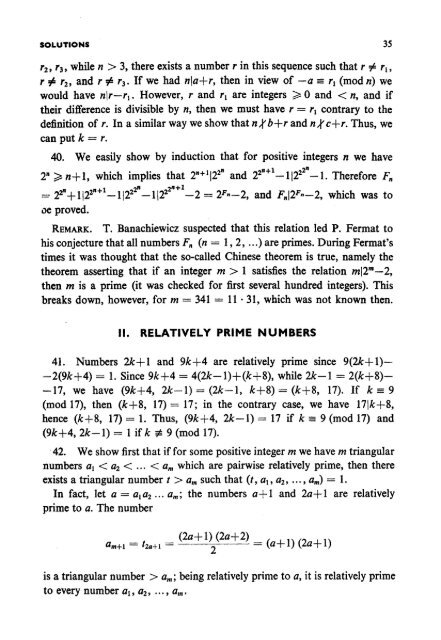250 Problems in Elementary Number Theory - Sierpinski (1970)
250 Problems in Elementary Number Theory - Sierpinski (1970)
250 Problems in Elementary Number Theory - Sierpinski (1970)
- No tags were found...
You also want an ePaper? Increase the reach of your titles
YUMPU automatically turns print PDFs into web optimized ePapers that Google loves.
SOLUTIONS3S'2, '3, while n > 3, there exists a number, <strong>in</strong> this sequence such that, :f: '1,, #: '2, and, ¢ '3. If we had nla+r, then <strong>in</strong> view of -a = '1 (mod n) wewould have n\r-r). However, rand rl are <strong>in</strong>tegers ~ 0 and < n, and iftheir difference is divisible by n, then we must have r = rl contrary to thedef<strong>in</strong>ition of r. In a similar way we show that n,t b+r and nA' c+r. Thus, wecan put k = r.40. We easily show by <strong>in</strong>duction that for positive <strong>in</strong>tegers n we have211 ~ n+l, which implies that 2"+112 2 " and 22,,+1_11222"_1. Therefore F"'J!' II + 1 2" 211 +1== 2 +112 2 -1122 -1122 -2 = 2 Fn -2, and F,.12 Fn -2, which was tooe proved.REMARK.T. Banachiewicz suspected that this relation led P. Fermat tohis conjecture that all numbers Fn (n = 1, 2, ... ) are primes. Dur<strong>in</strong>g Fermat'stimes it was thought that the so-called Ch<strong>in</strong>ese theorem is true, namely thetheorem assert<strong>in</strong>g that if an <strong>in</strong>teger m > 1 satisfies the relation mJ2m-2,then m is a prime (it was checked for first several hundred <strong>in</strong>tegers). Thisbreaks down, however, for m = 341 = 11 · 31, which was not known then.II. RELATIVELY PRIME NUMBERS41. <strong>Number</strong>s 2k+l and 9k+4 are relatively prime s<strong>in</strong>ce 9(2k+l)-2(9k+4) = I. S<strong>in</strong>ce 9k+4 = 4(2k-I)+(k+8), while 2k-1 = 2(k+8)--17, we have (9k+4, 2k-l) = (2k-l, k+8) = (k+8, 17). If k = 9(mod 17), then (k+8, 17) == 17; <strong>in</strong> the contrary case, we have 17Ik+8,hence (k+8, 17) = 1. Thus, (9k+4, 2k-l) = 17 if k = 9 (mod 17) and(9k+4, 2k-l) = 1 if k ;s 9 (mod 17) .. 42. We show first that if for some positive <strong>in</strong>teger m we have m triangularnumbers al < a2 < ... < am which are pairwise relatively prime, then thereexists a triangular number t > am such that (t, aI, a2, ... , am) = 1.In fact, let a = al a2 ... am; the numbers a+ 1 and 2a+ 1 are relativelyprime to a. The number(2a+l) (2a+2)am+l = t2Q+ 1 = 2 = (a+l) (2a+l)is a triangUlar number > am; be<strong>in</strong>g relatively prime to a, it is relatively primeto every number aI, a2, ... , am.


